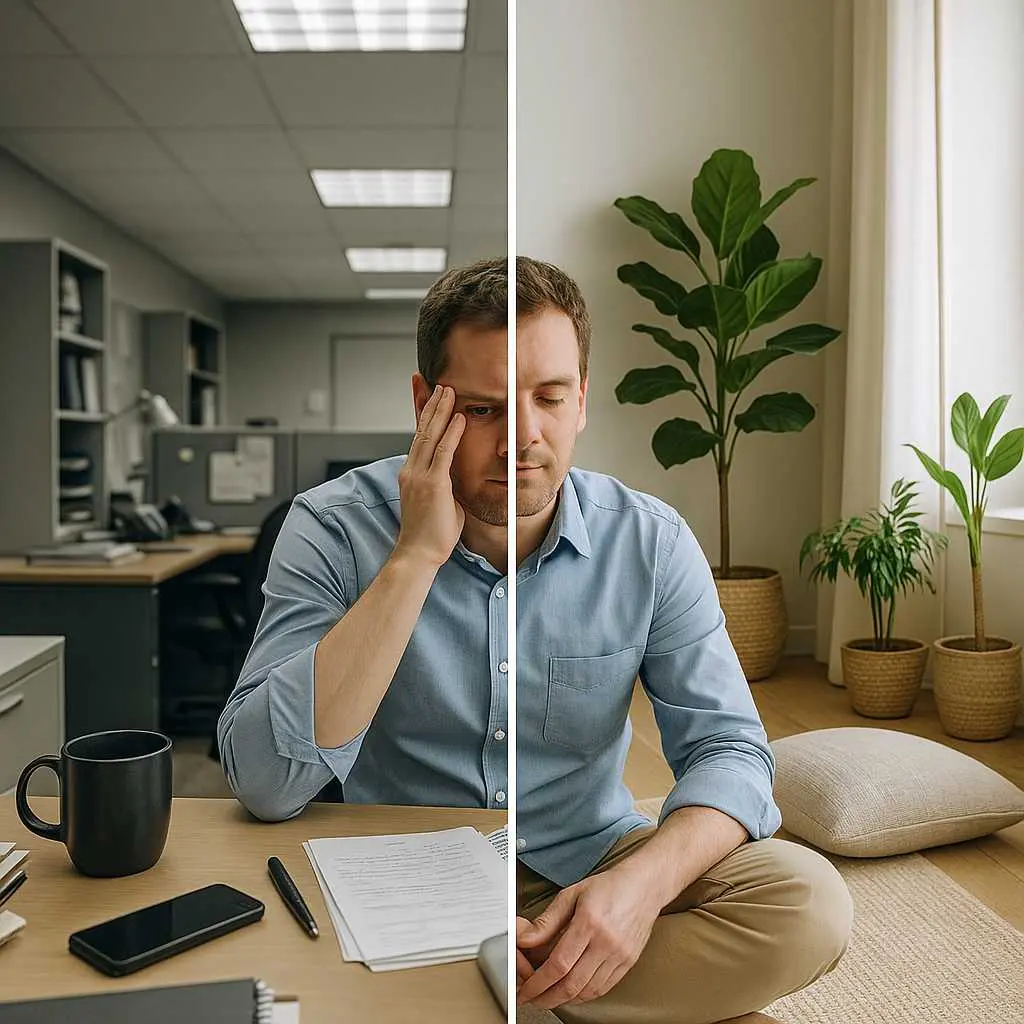My expertise in mindful design has revealed the importance of spaces that offer a mental reprieve. At Curvspace, we create emotional exits—areas designed to help users decompress. This article discusses how thoughtful design can craft calming spaces that unwind the mind and promote overall well-being.
Jump to:
Understanding the Psychology of Emotional Exits
The concept of emotional exits stems from our fundamental human need for psychological safety and restoration. These spaces function as transitional zones where the mind can shift gears, moving from states of stress and overstimulation to ones of calm and clarity. What makes these environments so powerful is their ability to engage multiple sensory pathways simultaneously, creating a holistic experience of decompression.
Consider how your body responds when you enter a space that feels immediately calming. Your shoulders might drop, your breathing deepens, and there’s often an almost audible sigh of relief. This physiological response isn’t accidental—it’s the result of carefully orchestrated design elements working in harmony to signal safety and restoration to your nervous system.
The most effective emotional exits understand that decompression isn’t a one-size-fits-all experience. Some individuals find restoration in enclosed, cocoon-like spaces that offer a sense of protection and intimacy. Others require open, expansive environments that provide a feeling of freedom and possibility. The key lies in creating spaces that can adapt to different emotional needs while maintaining their core function as places of mental reprieve.
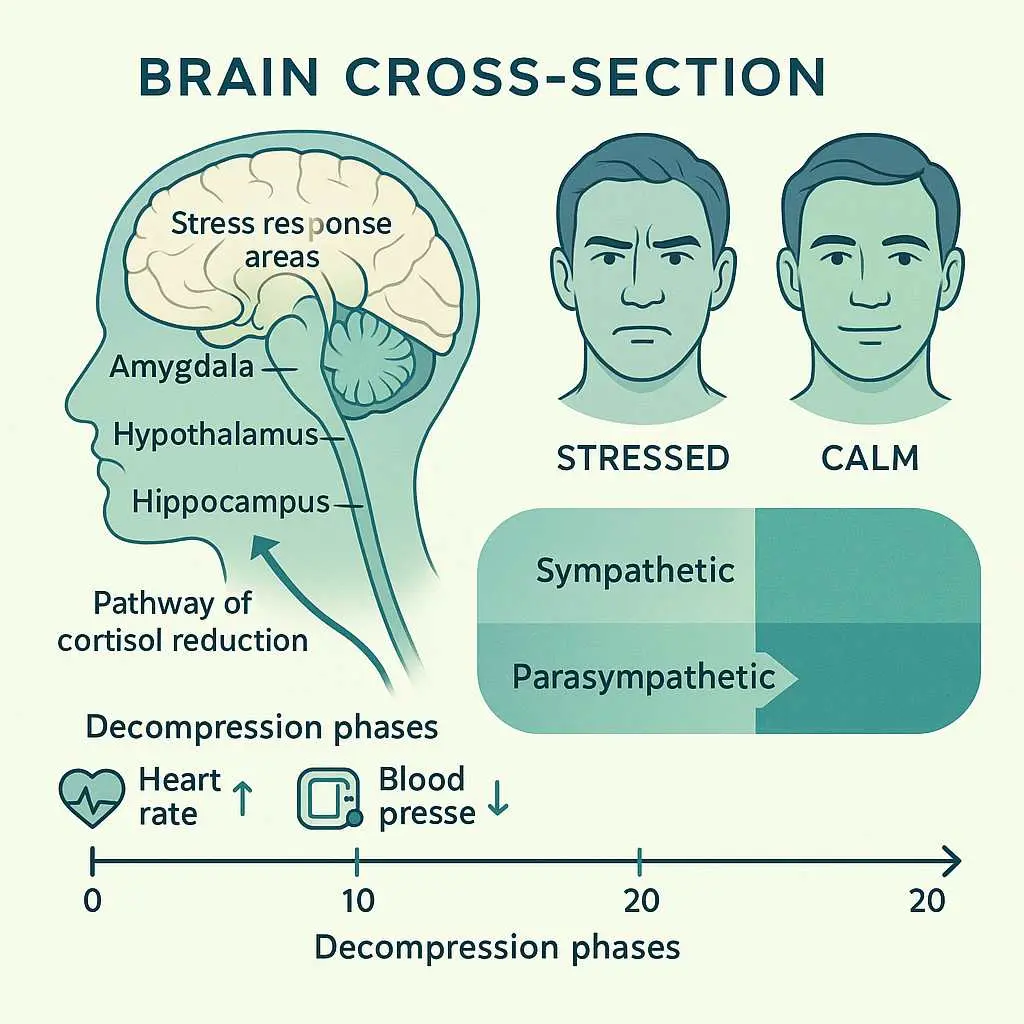
The Architecture of Calm: Design Elements That Matter
Creating effective emotional exits requires a deep understanding of how specific design elements influence our psychological state. The most successful calming spaces don’t rely on a single dramatic gesture but instead orchestrate multiple subtle interventions that work together to create an atmosphere of tranquility.
Natural Light as Emotional Medicine
Natural light serves as perhaps the most powerful tool in creating emotional exits. The quality, direction, and intensity of light can dramatically alter our mood and energy levels. In my experience designing decompression environments, I’ve found that soft, diffused natural light—the kind that filters through translucent materials or reflects off light-colored surfaces—creates the most restorative atmosphere.
The circadian benefits of natural light extend far beyond simple visibility. When we’re exposed to appropriate light levels throughout the day, our bodies maintain healthier sleep-wake cycles, which directly impacts our stress resilience and emotional regulation. In spaces where natural light is limited, carefully designed artificial lighting that mimics natural patterns can provide similar benefits.
Color Psychology in Stress Relief
The colors we surround ourselves with have a profound impact on our emotional state. Cool blues and greens have been shown to lower heart rate and blood pressure, while warm earth tones can create feelings of security and grounding. However, the most effective emotional exits often employ a more nuanced approach to color, using subtle variations and natural progressions that avoid the sterility of monochromatic schemes.
I’ve observed that spaces which incorporate what I call “emotional color journeys”—gradual transitions from one calming hue to another—tend to be more effective at facilitating decompression than those that rely on a single color palette. This approach acknowledges that our emotional needs change throughout our time in a space, and the environment should support this natural progression.
Texture and Material Selection
The tactile experience of a space plays a crucial role in its ability to serve as an emotional exit. Natural materials like wood, stone, and organic fibers provide a sensory connection to nature that can be deeply calming. These materials also tend to age gracefully, developing patinas and character that add to their emotional resonance over time.
The key is to create a rich tapestry of textures that invite touch and exploration while maintaining an overall sense of harmony. Rough textures can provide grounding and stability, while smooth surfaces offer a sense of calm and order. The interplay between these different tactile experiences creates a more engaging and restorative environment.
Biophilic Design: Bringing Nature Indoors
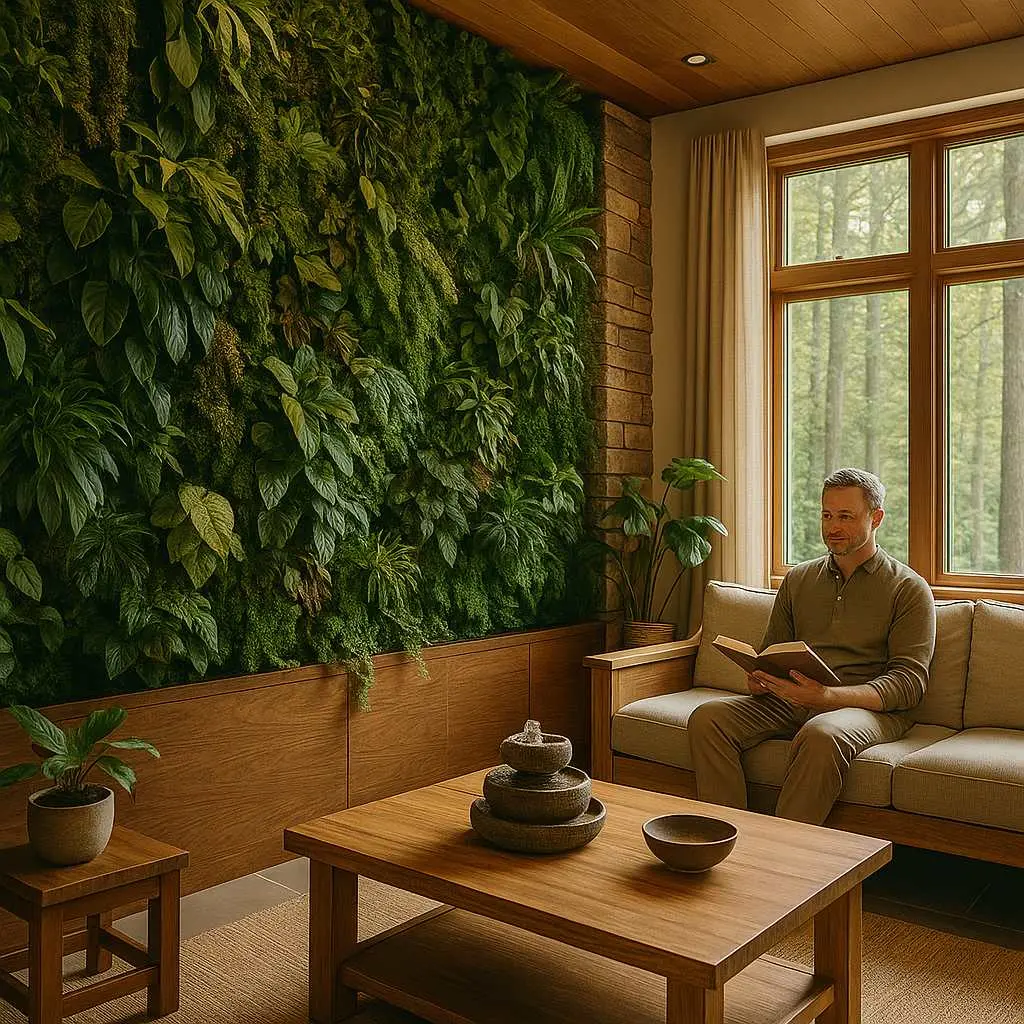
The integration of natural elements into interior spaces—known as biophilic design—represents one of the most effective strategies for creating emotional exits. Our innate connection to nature, what biologist E.O. Wilson termed “biophilia,” means that even small doses of natural elements can have significant psychological benefits.
Living Elements and Air Quality
Plants serve multiple functions in emotional exit spaces. Beyond their obvious aesthetic benefits, they actively improve air quality by filtering toxins and producing oxygen. This creates a measurably healthier environment that supports both physical and mental well-being. The presence of living elements also introduces subtle movements and changes that keep a space feeling dynamic and alive rather than static and sterile.
The selection of plants for decompression environments should consider both their air-purifying qualities and their sensory impact. Plants with soft, rounded leaves tend to feel more calming than those with sharp, angular foliage. Similarly, plants that release subtle fragrances can enhance the multisensory experience of the space.
Water Features and Sound
The sound of moving water has an almost universal calming effect, possibly because it masks distracting ambient noise while providing a consistent, rhythmic audio backdrop. In emotional exit spaces, water features can range from simple tabletop fountains to more elaborate installations, depending on the scale and purpose of the environment.
The key is to ensure that water sounds remain subtle and non-intrusive. The goal is to create a gentle audio foundation that supports relaxation rather than becoming a focal point that demands attention.

Spatial Configuration for Mental Decompression
The way we organize and configure space has a profound impact on how it functions as an emotional exit. Successful decompression environments understand the importance of creating what environmental psychologists call “prospect and refuge”—spaces that offer both a sense of safety and the ability to observe one’s surroundings.
Creating Zones of Intimacy
Within larger spaces, it’s important to create smaller zones that feel intimate and protected. These might be reading nooks with built-in seating, meditation corners with soft lighting, or simply areas defined by changes in ceiling height or material treatment. The goal is to provide options for different types of decompression activities while maintaining the overall coherence of the space.
These intimate zones should feel naturally separated from more active areas without being completely isolated. The ability to choose one’s level of engagement with the broader environment is crucial for effective stress relief.
Circulation and Flow
The way people move through an emotional exit space should feel natural and unhurried. Circulation paths should be generous enough to avoid feelings of constriction while providing clear wayfinding that doesn’t require conscious navigation. The goal is to create a sense of gentle progression through the space that supports the mental transition from stress to calm.
Consider how different circulation patterns affect the emotional experience of a space. Curved paths tend to feel more relaxing than straight ones, while multiple route options provide a sense of choice and control that can be psychologically beneficial.
Technology Integration in Calming Spaces
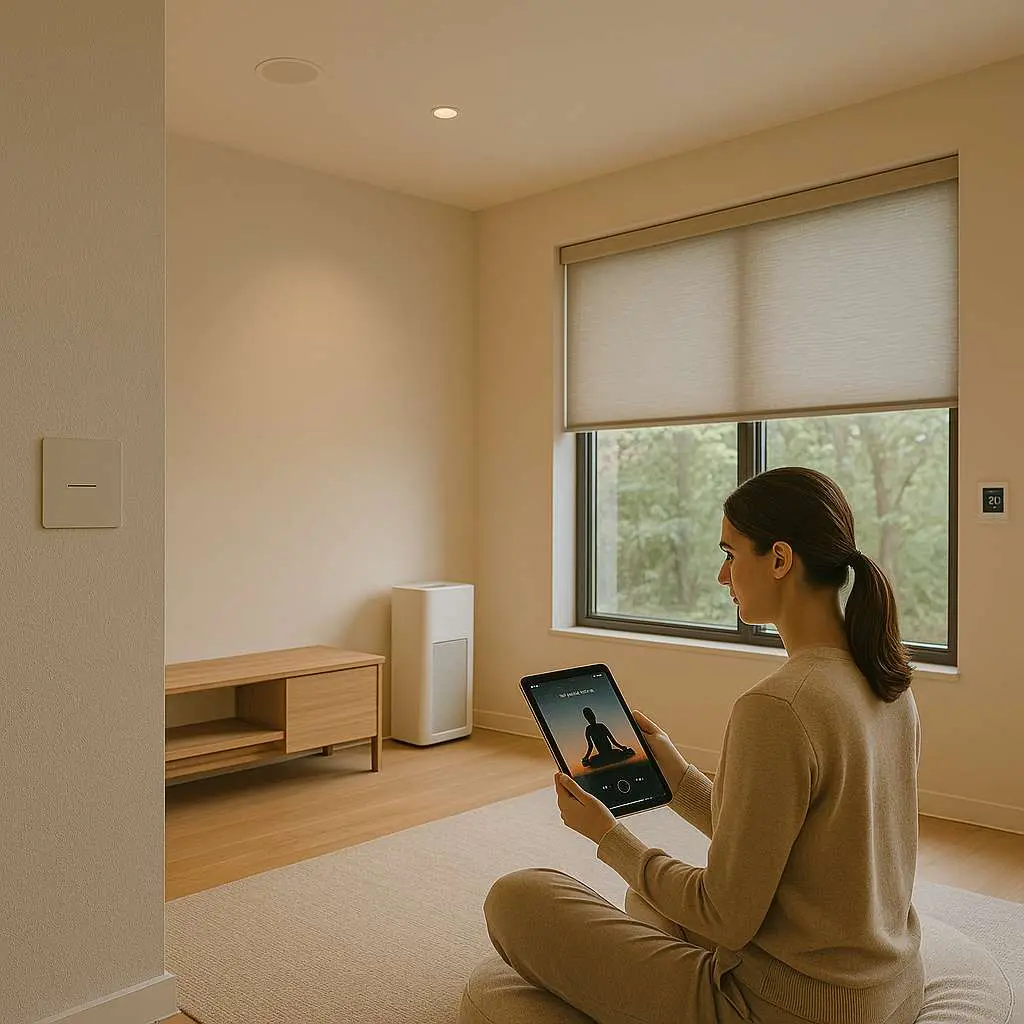
While the focus of emotional exits is often on natural and traditional elements, thoughtful technology integration can enhance their effectiveness without compromising their restorative qualities. The key is to ensure that technology remains invisible and supportive rather than intrusive or demanding of attention.
Smart Environmental Controls
Automated systems that adjust lighting, temperature, and humidity based on time of day and occupancy can help maintain optimal conditions for relaxation without requiring conscious management. These systems should operate silently and seamlessly, creating an environment that feels naturally perfect rather than artificially controlled.
The most effective implementations of smart technology in emotional exit spaces are those that learn from user behavior and preferences, gradually optimizing the environment for maximum restorative benefit.
Sound Management and Acoustic Design
Controlling the acoustic environment is crucial for creating effective emotional exits. This involves both managing unwanted noise and introducing beneficial sounds. Sound-absorbing materials, strategic placement of soft furnishings, and careful attention to HVAC noise can create a quieter baseline that supports relaxation.
Some spaces benefit from the introduction of nature sounds, ambient music, or even guided meditation audio. The key is to provide options and controls that allow users to customize their auditory experience based on their current needs and preferences.
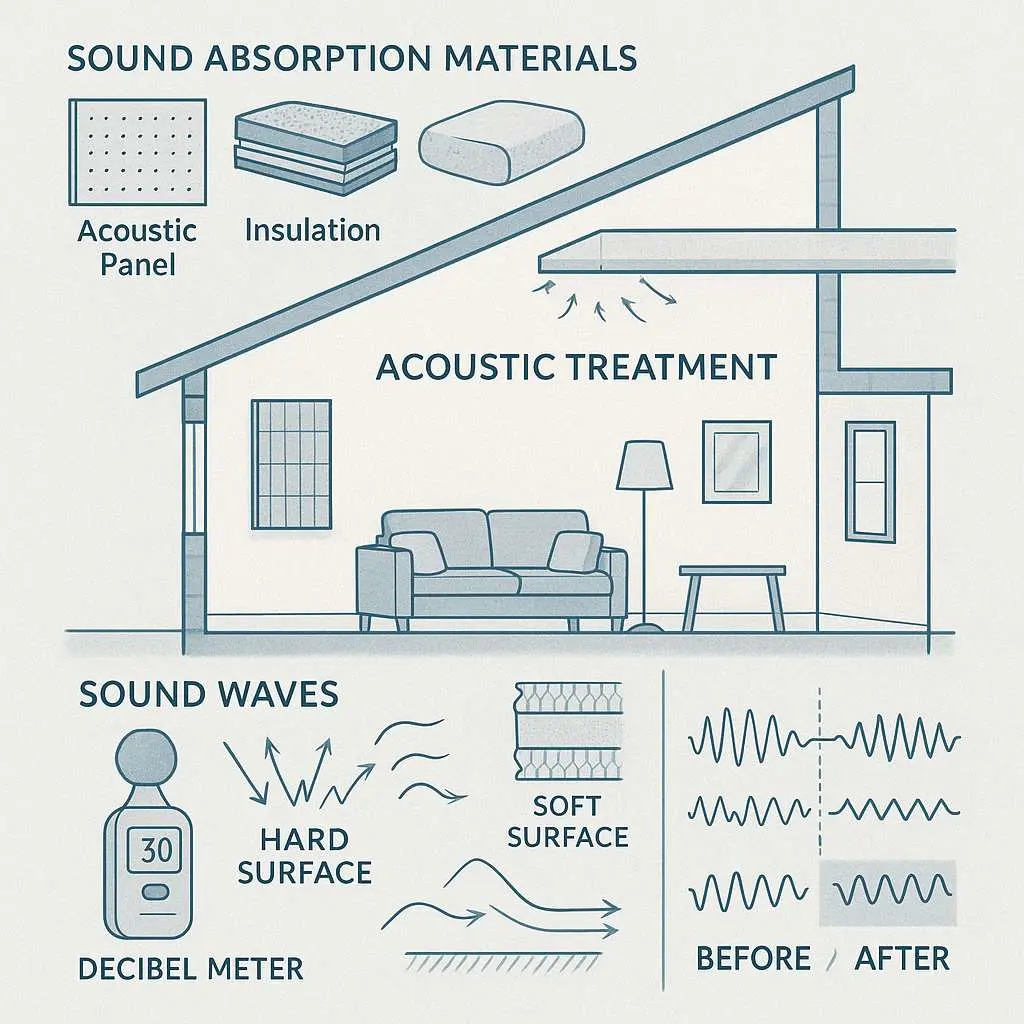
Workplace Applications: Bringing Emotional Exits to Professional Environments
The integration of emotional exits into workplace design has become increasingly important as organizations recognize the connection between employee well-being and productivity. These spaces serve as crucial pressure valves in high-stress professional environments, providing opportunities for mental reset and restoration throughout the workday.
Designing for Different Work Styles
Modern workplaces accommodate diverse work styles and personality types, and emotional exit spaces should reflect this diversity. Some employees find restoration in quiet, solitary environments, while others benefit from gentle social interaction. The most effective workplace decompression areas provide options for both individual and small group use.
Consider creating a variety of settings within a single emotional exit space: a quiet reading area with comfortable seating, a meditation corner with floor cushions, and perhaps a small social zone with soft seating arranged for conversation. This approach acknowledges that decompression needs vary not only between individuals but also for the same person at different times.
Integration with Workflow
Emotional exits should be strategically located to encourage regular use without disrupting workflow. Placing these spaces near natural transition points—between different work zones, near elevators, or adjacent to common areas—makes them more likely to be discovered and utilized. The goal is to make decompression feel like a natural part of the work rhythm rather than a special destination that requires planning.
The most successful workplace emotional exits are those that feel integrated into the overall design narrative of the office while maintaining their distinct identity as restorative spaces. This might involve using similar materials and color palettes while adjusting lighting levels and acoustic treatments to create a noticeably calmer atmosphere.
Lorem Ipsum Heading 3
Lorem Ipsum is simply dummy text of the printing and typesetting industry. Lorem Ipsum has been the industry’s standard dummy text ever since the 1500s, when an unknown printer took a galley of type and scrambled it to make a type specimen book. It has survived not only five centuries, but also the leap into electronic typesetting, remaining essentially unchanged.
Residential Emotional Exits: Creating Sanctuary at Home
The home environment offers unique opportunities for creating emotional exits because of the greater control residents have over their surroundings and the ability to personalize spaces based on individual preferences and needs. Home-based decompression environments can be more intimate and specifically tailored than their public or workplace counterparts.
Adapting to Existing Architecture
Not every home has the luxury of a dedicated room for relaxation, but emotional exits can be created within existing spaces through thoughtful design interventions. A corner of a bedroom can become a meditation nook with the addition of a comfortable cushion, soft lighting, and perhaps a small plant. Even a section of a hallway can serve as a transitional decompression zone with the right treatment.
The key is to identify spaces that feel naturally separated from high-activity areas while still being easily accessible. These might be areas with good natural light, interesting architectural features, or simply spaces that feel psychologically removed from the demands of daily life.
Personalization and Meaning
Home-based emotional exits benefit from personal touches that create emotional resonance for the inhabitants. This might include meaningful artwork, photographs, books, or objects that have special significance. The goal is to create a space that feels deeply personal while maintaining its function as a place of restoration and calm.
Personal meaning can also be created through the design process itself. Involving family members in the selection of colors, materials, and furnishings can create a sense of ownership and investment that enhances the space’s effectiveness as an emotional exit.
The Role of Scent and Air Quality in Emotional Exits
The olfactory dimension of emotional exit design is often overlooked but can be incredibly powerful in creating immediate psychological shifts. Our sense of smell is directly connected to the limbic system, the part of the brain responsible for emotion and memory, making scent one of the fastest ways to influence mood and stress levels.
Natural Aromatherapy Integration
Rather than relying on artificial fragrances, effective emotional exits often incorporate natural scent sources that provide aromatherapy benefits while maintaining air quality. This might include plants with naturally fragrant leaves, essential oil diffusers with calming scents like lavender or eucalyptus, or even the natural scents of wood and other organic materials.
The key is subtlety—scents in emotional exit spaces should be barely perceptible, creating a subliminal sense of well-being rather than an obvious fragrance experience. Strong scents can be overwhelming and counterproductive to the goal of creating a calming environment.
Air Quality and Ventilation
Clean, fresh air is fundamental to any effective emotional exit space. Poor air quality can create feelings of stuffiness and discomfort that work against the goal of relaxation and restoration. Proper ventilation, air filtration, and humidity control create the foundation for a healthy and comfortable environment.
In spaces where natural ventilation isn’t possible, mechanical systems should operate quietly and efficiently, providing fresh air without creating noise or drafts that might be distracting or uncomfortable.
Cultural Considerations in Emotional Exit Design

The concept of emotional exits and the design elements that support them can vary significantly across different cultures and communities. What feels calming and restorative to one group might feel unfamiliar or even uncomfortable to another. Effective emotional exit design considers the cultural context and preferences of its intended users.
Universal vs. Cultural Elements
While certain elements of calming design appear to be nearly universal—such as the benefits of natural light and the calming effect of nature sounds—others are more culturally specific. Color associations, spatial preferences, and even attitudes toward privacy and social interaction can vary significantly between different cultural groups.
The most inclusive approach to emotional exit design incorporates elements that have broad appeal while avoiding those that might be culturally specific or potentially alienating. This often means focusing on fundamental human needs for comfort, safety, and connection to nature while allowing for personal and cultural customization.
Community Input and Co-Design
When creating emotional exits for diverse communities, involving potential users in the design process can ensure that the resulting spaces truly serve their intended purpose. This might involve surveys, focus groups, or more formal co-design processes that give community members a voice in shaping their decompression environments.
This collaborative approach not only results in more effective spaces but also creates a sense of ownership and investment that can enhance the community’s relationship with the emotional exit over time.
Measuring Success: How to Evaluate Emotional Exit Effectiveness
Understanding whether an emotional exit space is truly serving its intended purpose requires both quantitative and qualitative assessment methods. The most comprehensive evaluation approaches combine objective measures of space usage with subjective feedback about user experience and perceived benefit.
Usage Patterns and Behavioral Observation
Simple observation of how people use emotional exit spaces can provide valuable insights into their effectiveness. Are people spending time in the space? Do they appear relaxed and comfortable? Are they returning regularly? These behavioral indicators can suggest whether the space is meeting its intended goals.
More sophisticated analysis might involve tracking usage patterns over time, noting peak usage periods, and observing how different design elements are utilized. This information can inform future design decisions and help optimize the space for maximum benefit.
User Feedback and Satisfaction Surveys
Direct feedback from users provides crucial insights into the subjective experience of emotional exit spaces. Regular surveys or informal feedback sessions can reveal what’s working well and what might need adjustment. Questions might focus on perceived stress reduction, comfort levels, and overall satisfaction with the space.
The most valuable feedback often comes from regular users who can speak to the long-term benefits of having access to emotional exit spaces. These individuals can provide insights into how the spaces fit into their daily routines and contribute to their overall well-being.
Future Trends in Emotional Exit Design
As our understanding of environmental psychology and neuroscience continues to evolve, new opportunities are emerging for creating even more effective emotional exit spaces. These developments promise to make decompression environments more responsive, personalized, and beneficial for users.
Biometric Integration and Responsive Environments
Emerging technologies allow for real-time monitoring of stress indicators like heart rate variability, skin conductance, and even brainwave patterns. Future emotional exit spaces might incorporate these technologies to automatically adjust environmental conditions based on users’ physiological state, creating truly responsive decompression environments.
While these technologies raise important privacy considerations, they also offer the potential for unprecedented personalization of emotional exit experiences. Imagine a space that could detect your stress level upon entry and automatically adjust lighting, temperature, and even scent to optimize your relaxation experience.
Virtual and Augmented Reality Applications
VR and AR technologies offer new possibilities for creating immersive emotional exit experiences, particularly in spaces where physical design options are limited. These technologies could transport users to virtual natural environments, provide guided meditation experiences, or create personalized relaxation scenarios.
The key to successful integration of these technologies will be ensuring that they enhance rather than complicate the emotional exit experience. The goal should always be to support relaxation and decompression, not to create additional technological demands on users.
People Also Ask
How long should someone spend in an emotional exit space to experience benefits?
Research suggests that even brief exposures to calming environments can begin to reduce stress indicators within 2-5 minutes. However, for deeper restoration and significant cortisol reduction, spending 10-20 minutes in a well-designed emotional exit space is typically more beneficial. The key is consistency rather than duration—regular short visits often provide more cumulative benefit than occasional longer sessions.
Can emotional exit spaces be effective in small areas or do they require dedicated rooms?
Emotional exits can be highly effective in small spaces or even corners of existing rooms. The key factors are creating a sense of separation from high-stress activities, incorporating calming design elements like soft lighting and natural materials, and ensuring the space feels intentionally designed for relaxation. Even a well-designed reading nook or meditation corner can serve as an effective emotional exit.
What’s the difference between an emotional exit space and a regular relaxation area?
Emotional exit spaces are specifically designed with environmental psychology principles to facilitate the transition from stress to calm. Unlike general relaxation areas, they incorporate evidence-based design elements like specific lighting conditions, acoustic treatments, biophilic elements, and spatial configurations that actively support nervous system regulation. The design is intentional and research-informed rather than simply comfortable or aesthetically pleasing.
Conclusion
Creating effective emotional exits requires understanding the deep connection between our environment and our psychological well-being. These spaces offer more than aesthetic appeal—they provide essential mental health infrastructure for our increasingly demanding world. At Curvspace, we’re committed to designing environments that truly support human flourishing through thoughtful, evidence-based design.
Ready to transform your space into an emotional sanctuary? Contact Curvspace today to explore how we can create your perfect decompression environment.
References
- Farb, N. A., et al. (2010). Attending to the present: mindfulness meditation reveals distinct neural modes of self-reference. Social Cognitive and Affective Neuroscience, 5(4), 313-322.
- Sarah Barnard Design. (2023). How Interior Design Can Facilitate Mindfulness and Reduce Stress and Burnout.
- Garden on the Wall. (2024). Designing for Stress Reduction: Calming Interiors in High-Pressure Environments.
- Punnuwasu. (2025). Mindful Spaces: How Environmental Psychology Can Boost Your Well-being.
- Curvspace. (2025). Moments of Pause: Crafting In-Between Time.
- B.R. Howard. (2019). How to look at art: 30 mindful questions to ask yourself.
- K.R.E Concept. (2022). Designing relaxation areas: 5 tips for success.
- Calm. (2023). Visualization meditation: 8 exercises to add to your practice.
- Illustrarch. (2024). Top Features of Spaces Designed to Improve Mental Health and Well-being.
- Interior Design. (2023). 15 Relaxation Rooms Designed to Create Calm.
Disclosure
Our content is reader-supported. This means if you click on some of our links, then we may earn a commission. Commissions do not affect our editor’s opinions or evaluations. Learn more about our editorial process.

About the Editorial Staff
The Curvspace editorial team comprises a diverse group of experts on intermediate and threshold spaces in homes and workplaces. Architects and interior designers, civil engineers and artists, environmental and behavioral psychologists, sociologists and anthropologists. All collaborate to create helpful content, that explores the full potential of these often-overlooked areas to enhance our daily lives.

